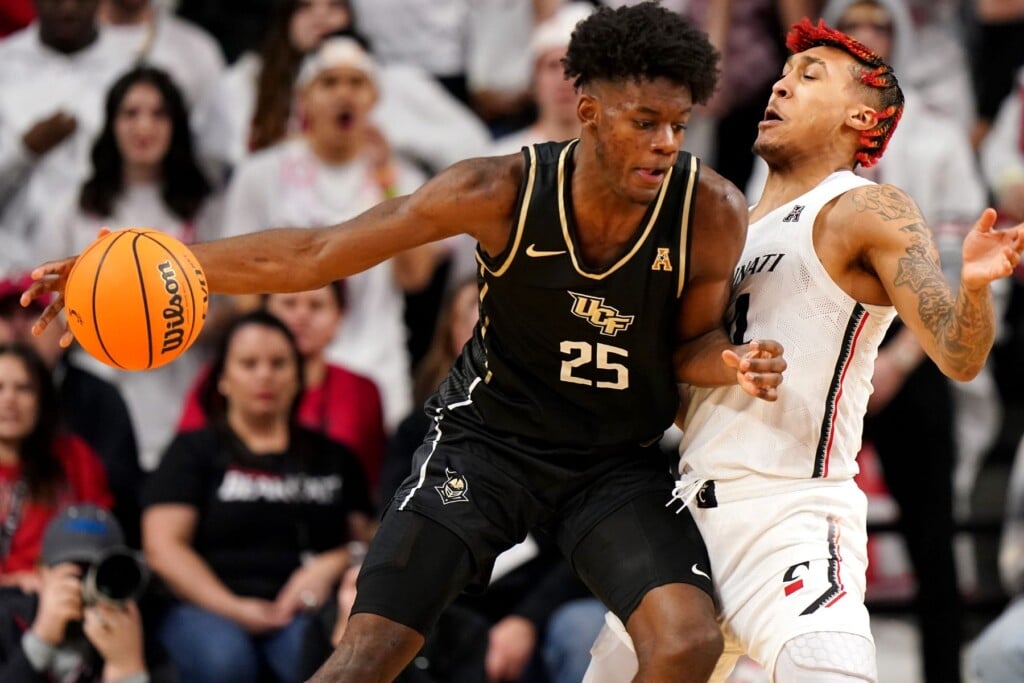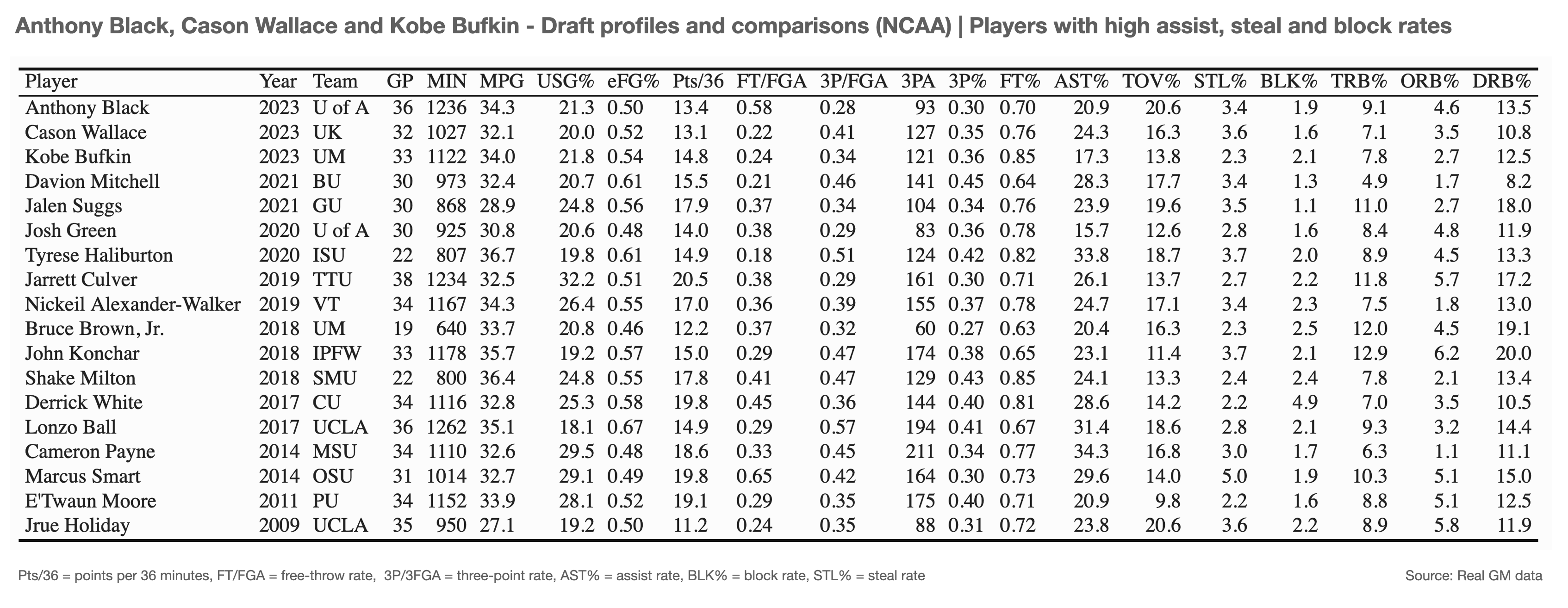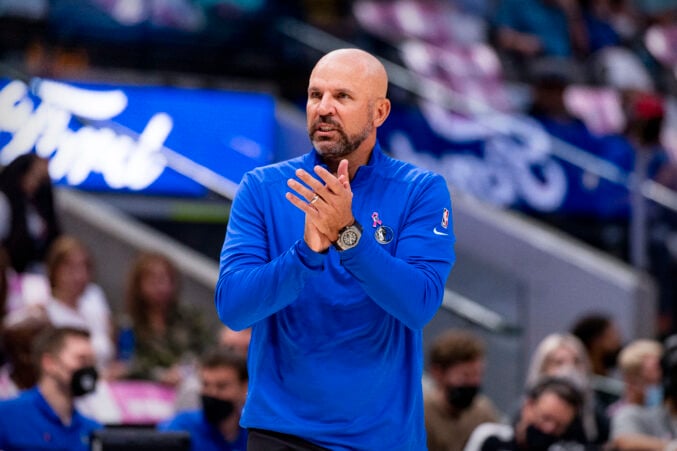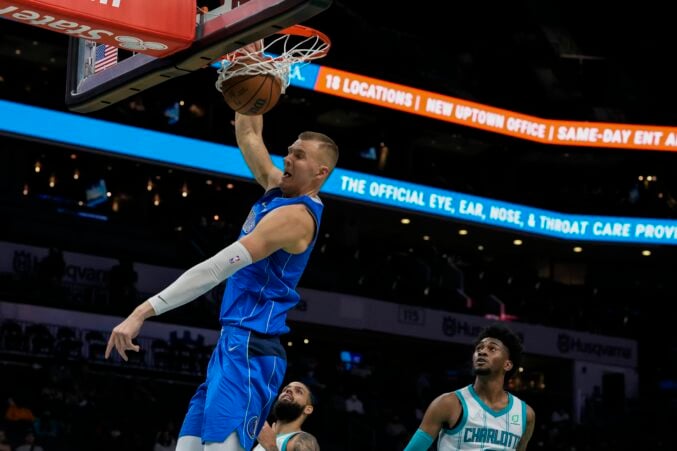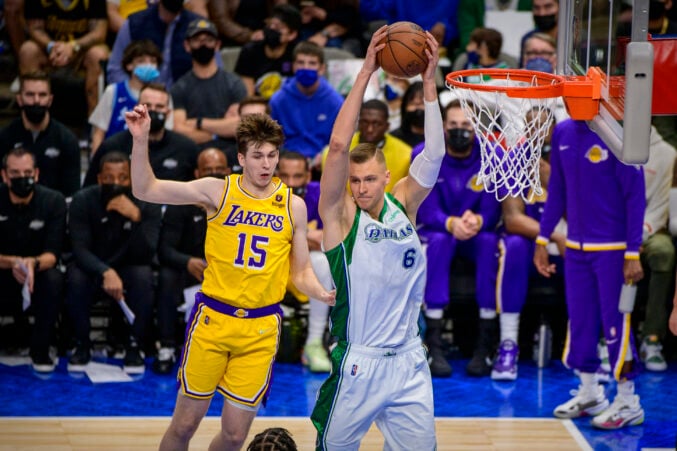The pace of the NBA is relentless. Merely a week has passed since the 2022-23 season ended with the Nuggets claiming their first title by triumphing over the Heat. Now the next couple of weeks carry immense significance as they hold the potential to shape the season that follows and beyond. We’re entering a critical period in the NBA calendar, beginning with the draft on Thursday and the start of free agency eight days later.
In the grand scheme of things, the ability of the Mavericks’ front office to re-sign Kyrie Irving, the most high-profile free agent in the league entering the offseason, to a deal is what matters most. Especially considering the significant investment that was made to bring Irving to Dallas back in February—two rotational players and a first-round pick. (That came on the heels of the fiasco with Jalen Brunson a year ago.) First, however, there is the matter of the draft, and the franchise’s decision-makers must decide what to do with one of their most valuable assets: the 10th pick in the proceedings.
After the lottery, I wrote that the best way to utilize the pick was to trade it. I still feel that way, and nothing that has transpired in the past six months—ESPN’s Tim MacMahon reporting Luka Doncic’s desire for more help, the Irving trade, chatter continuing to percolate that the front office is heavily interested in moving the pick for immediate contributors—leads me to believe the Mavs are not in win-now mode. There are plenty of holes to fill on the roster, and deficiencies need to be addressed on defense and in the rebounding and size departments. That’s why it’s no surprise that signals from Mavericks camp suggest their priorities are improving the defense and looking for length and athleticism. It’s also why the trade rumors associated with names like John Collins and Buddy Hield don’t make much sense to me, while the ones involving Clint Capela do.
But let’s say the Mavericks ultimately decide that their best play is to keep the pick. There are some intriguing prospects in the draft who could address some of the needs if they keep the pick or trade down, a more likely scenario. The latter strategy—adding a player who could help now along with a prospect who would add youth and athleticism—might be the way to reshape a guard- and offense-heavy roster toward a more balanced one, one with more defense and beef in the frontcourt. For more than a decade, the Mavericks have lacked an elite defender worthy of an all-defense selection, but this year’s draft offers a chance to alter that narrative.
But, who? To save everyone time poring through draft reports, I crunched some numbers to identify some of these players based on their advanced stats, including rebounding and block and steal rates, all categories in which the Mavericks ranked near the bottom of the league last season. I also contextualized some of these stats alongside NBA players who displayed similar profiles early in their careers, to give us a better sense of what these prospects could someday become. Lastly, and perhaps most importantly: a barometer for who might actually fall to No. 10 versus who you shouldn’t hold your breath hoping to see in Dallas next season.
Wishful Thinking
Houston’s Jarace Walker would address the Mavericks’ biggest need by adding positional size (his combine measurements came in at 6-foot-7 with a 7-foot-2 wingspan), athleticism, strength and defense in the frontcourt. The problem? He is ranked sixth on the consensus 2023 draft big board, and there is only a 6 percent chance he would be available at No. 10, according to FanDuel odds.
If he does somehow slip to 10, he’d present a compelling case for the Mavericks to seriously consider retaining the pick.
Could Happen, But Not Likely
I have Taylor Hendricks of Central Florida and Anthony Black of Arkansas here, even if both are projected to be gone before the Mavericks make their selection. (Per FanDuel, the chances that Black will be available at 10 are 11 percent; they are 21 percent for Hendricks.)
Like Walker, Hendricks is a prospect who would add positional size at the power forward position. He’s 6-foot-9 with an almost 7-foot-1 wingspan. Hendricks’ combination of shooting (three-point rate and three-point accuracy), defensive versatility, and rim protection (block rate) looks like a perfect fit in the modern NBA, especially next to a playmaker like Doncic.
The floor, in terms of past prospects with similar profiles, is not all that exciting (Chuma Okeke, Jalen Smith, and D.J. Wilson come to mind). But the ceiling—the potential of a weak-side rim protector in the mold of Chris Boucher or Jonathan Isaac, with better shooting—is what makes Hendricks so appealing.
Black, who starred in high school at Coppell and then Duncanville, is another prospect who provides athleticism, length, and a defensive presence. Simply put, playmaking guards (with an assist rate above 20 percent) who can generate turnovers (steal rate above 2 percent) and have the length and athleticism to block shots (a block rate above 1.5 percent) are not easy to find. Another prospect, Cason Wallace, also fits that profile. (More on him in a minute.)
With Doncic, Irving (assuming he’s back), Josh Green, Reggie Bullock, Jaden Hardy, and Tim Hardaway Jr., the Mavericks already have plenty of guards. So adding another backcourt player—albeit one with a 6-foot-7 frame, which makes him a versatile and switchable defender—would not be ideal and would require additional roster reshuffling. As with most other players in this exercise, the ability to shoot (Black made only 30 percent of his threes in his one season at Arkansas) is what will probably make or break him as a full-time starter in the NBA. I’ve seen some Lonzo Ball and Josh Giddey comparisons. But while Black has a high basketball IQ, his assist rate doesn’t project him to be on that elite level as a passer.
You Can Have Him, But You Should Move Down to Get Him
Presuming none of the aforementioned three players slip to 10, Dallas’ best move might be to move the pick and acquire a dependable player for the rotation, a la Marc Stein’s report of a potential trade involving the Mavericks and the Hawks swapping the 10th and 15th selections, with Atlanta throwing in a veteran player as makeweight. If the Mavericks do that while getting their hands on Wallace or Dereck Lively II, that would be a home run. It won’t be easy as the consensus draft projection for both is in the 12-to-13 range, with Lively climbing up as high as 10 in some of the latest mock drafts.
Wallace (my personal favorite) is another prospect with the potential to become an elite defender. Despite standing only 6-foot-3, he has long arms—his wingspan of 6-foot-8 is an inch longer than Black’s. The Richardson High alum is an exceptional defensive guard who possesses strength and remarkable hands, as evidenced by his high steal rate compared to other players in my analysis. He could become a disruptive point-of-attack defender, a crucial piece the Mavericks are in dire need of. While he’s not a lethal shooter, he was a bit better than Black at converting on spot-up opportunities in his lone season at Kentucky. He would, however, fall into the same bucket as Black of being yet another guard on a roster full of them, and the offensive fit probably wouldn’t be as smooth as Black’s, either.
Among all the prospects I analyzed, Lively stands out as the most captivating, the best center prospect in the draft after Victor Wembanyama. Standing at 7-foot-1, he possesses a lanky physique reminiscent of a young JaVale McGee, with an extraordinary 7-foot-7 wingspan that ranks second only to Mo Bamba among the players in my analysis.
After a slow start at Duke last season, Lively established himself as the most impactful defender in college basketball, leading all players in defensive box plus/minus. Shot blocking is a skill that translates well from college to the NBA; five players with similar profiles in my comparison (Walker Kessler, Isaiah Jackson, Nicolas Claxton, Christian Koloko, Myles Turner) ranked in the top 10 in the NBA in block percentage last season.
Statistically, his closest comparison is another former Mavericks center, Willie Cauley-Stein, which is not exactly what you’re going for. Similarly to Cauley-Stein when he entered the league, he is raw offensively, as evidenced by the lowest usage and scoring (points per 36 minutes) numbers among all centers in this exercise. But Lively is also mobile enough to be more than a drop-back big who protects the rim. He is a project who will take time to develop, but if he does, the 19-year-old could become the long-term rim-protecting solution the Mavericks thought they were getting in the 35-year-old McGee last season. The question is whether the Mavericks can afford to be patient.
The Wild Card
Bilal Coulibaly has surged up draft rankings, and is currently projected to be selected anywhere from ninth to 17th. Which is to say, he could be off the board before Dallas gets on the clock, or he could be in the sweet spot of prospects who might be available if the Mavericks move back to try and pick up another asset. Your guess is as good as mine.
What’s certain is Coulibaly is a specimen, measuring in at 6-foot-8 with an impressive 7-foot-2 wingspan. He’s also as high-risk, high-reward as it gets. Like Lively he is raw offensively; he has the lowest usage rate among similar players who were drafted out of the French league. Another Maverick, Frank Ntilikina, was the only French prospect in my analysis with lower per-36-minute scoring numbers. Again, not what you’re going for.
The track record of defensive-minded French wing players chosen in the NBA draft has not been particularly impressive, either. Ntilikina, Sekou Doumbouya (selected 15th by the Pistons in 2019), and Guerschon Yabusele (16th by the Celtics in 2016) struggled to establish themselves due to shooting limitations. This is not to suggest Coulibaly will not work out; rather, it’s a reminder of the risk involved in taking on such a project. On the flip side, Coulibaly has probably better physical tools than all of them, and at 18, he has shown flashes of being a disruptive defensive player in the French league. Coulibaly ranked third in the league in opponent’s point per possession for players who defended more than 100 possessions. Opponents shot minus-0.21 below expectation on 118 possessions defended by Coulibaly, based on the Synergy SSM metric.
According to the international scouts I spoke with, the consensus is that Coulibaly will require ample time and development minutes to thrive in the NBA. Unfortunately, if the Mavericks don’t have the luxury of waiting with Lively, they most certainly don’t with Coulibaly.
These aren’t the only names, mind you. If the Mavericks trade further down in the first round, other players who fit the profile of a long and athletic prospect might be available. G League prospect Leonard Miller, a 6-foot-10 forward with a 7-foot-2 wingspan, has the tools to develop into a long defender, while Michigan guard Kobe Bufkin’s stock has shot up in the last month and compared well in defensive metrics in my analysis. Noah Clowney, a stretch big out of Alabama, is another long (6-foot-10 with a 7-foot-2 wingspan) and potentially versatile defender. Ryan Rupert, who played last season in Australia’s NBL, is another athletic long-armed (7-foot-3 wingspan) Frenchman who excels at defense but has a raw offensive game.
The bottom line is the Mavericks have options. And as my colleague Brian Dameris wrote, tons of combinations are at play for the front office to evaluate and explore in the offseason. Thursday night will provide the first peek. Whatever they decide, the Mavericks have to take the first step toward reconstructing a more balanced roster.
Get the ItList Newsletter
Author


